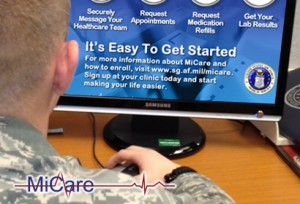
The study looked at the Air Force's MiCare PHR.
The failure of Google Health in 2011 pointed to a critical question about patient health records (PHRs): do people want them? If a giant like Google couldn't get enough people interested in their own health records to continue offering the service, what hope was there for mass market penetration. With Meaningful Use Stage 2 requiring hospitals to not only offer patient access to their records, but that at least 5 percent of patients actually access them, the question has never been more salient.
A recent study in the Journal of Medical Internet Research aimed to look at the question of PHR adoption in the context of an employer program. The University of Maryland's Dr. Ritu Agarwhal and her research team conducted an observational study at Elmendorf Air Force Base in Alaska in December 2010, as the base was launching its MiCare opt-in PHR and secure messaging system. Only about 7 percent of the patients at the base invited to register for the PHR system actually did so: 1,801 out of some 26,000. Of those, 283 completed surveys about how they intended to use the records.
"The survey sample was significantly older, higher paid, more sick, and more likely to be female than the [overall] Elmendorf population," the study reports. "The survey sample was also older, higher paid, more sick, and more likely to be active duty than early adopters who chose not to complete the survey. These differences were consistent with findings from other studies which examined usage patterns of secure messaging and found usage to be higher for women, individuals with higher levels of education, and increased morbidities. Education information was not available from the Air Force databases, but income was often correlated with education." They also found that most of the survey group rated their computer skills as "quite extensive" or "very extensive."
In addition to these broad demographic trends, Agarwhal and her team found a link between patients' current satisfaction with their health provider and adoption of the PHR, suggesting that one thing providers can do to increase adoption is to build strong relationships with patients. They also found that communication about the PHR tool needed to be specific and personalized. In the study, they found that respondents who considered record keeping the most important function of the PHR were less likely to use it, possibly because the marketing materials downplayed the record-keeping functionality compared to the patient-provider engagement functions.
In general, the study found that effective communication from the employer was a bigger factor in adoption intention than whether a patient thought the system would be useful.
"The health care process management support function of the PHR represents a two-way street between the patient and provider (eg, scheduling appointments, exchanging messages)," the study says. "It is not surprising that the patient needs to perceive that the other party in the exchange believes in the benefits of the system as well. Communication tactics help reinforce this message. Organizations planning a PHR implementation should carefully craft a communication strategy suited to their organization’s needs to improve the likelihood of a high adoption rate, resulting in the highest return on their investment in the technology."
















